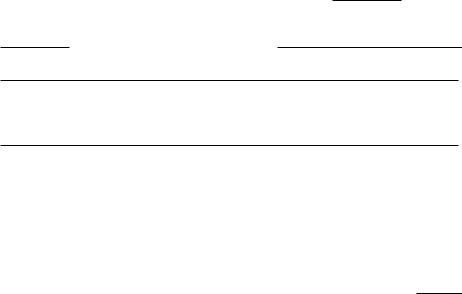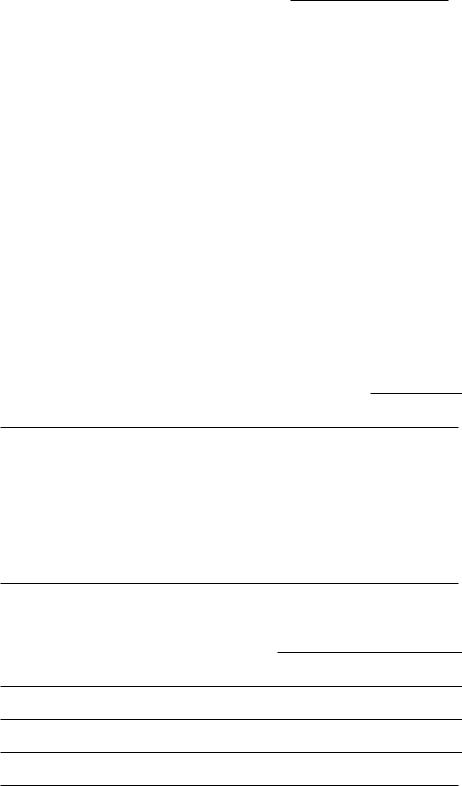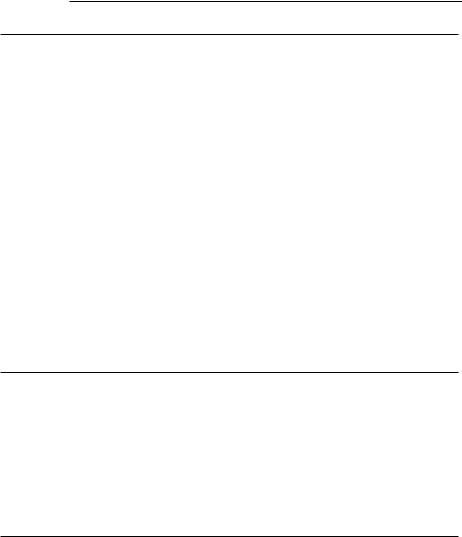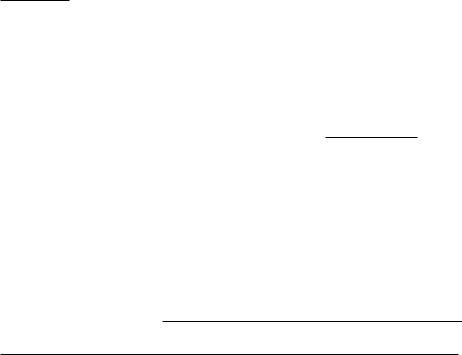
Varian Microeconomics Workout
.pdf
An auction is described by a set of rules. The rules specify bidding procedures for participants and the way in which the array of bids made determines who gets the object being sold and how much each bidder pays. Those who are trying to sell an object by auction typically do not know the willingness to pay of potential buyers but have some probabilistic expectations. Sellers are interested in ¯nding rules that maximize their expected revenue from selling the object.
Social planners are often interested not only in the revenue generated from an auction method, but also in its e±ciency. In the absence of externalities, an auction for a single object will be e±cient only if the object is sold to the buyer who values it most highly.
17.1 (1) At Toivo's auction house in Ishpemming, Michigan, a beautiful stu®ed moosehead is being sold by auction. There are 5 bidders in attendance: Aino, Erkki, Hannu, Juha, and Matti. The moosehead is worth $100 to Aino, $20 to Erkki, and $5 to each of the others. The bidders do not collude and they don't know each others' valuations.
(a) If the auctioneer sells it in an English auction, who would get the
moosehead and approximately how much would the buyer pay?
.
(b) If the auctioneer sells it in a sealed-bid, second-price auction and if no bidder knows the others' values for the moosehead, how much should
Aino bid in order to maximize his expected gain? |
|
How much |
||
should Erkki bid? |
|
How much would each of the others bid? |
||
Who would get the moosehead and how much would he pay?
.
17.2 (2) Charlie Plopp sells used construction equipment in a quiet Oklahoma town. He has run short of cash and needs to raise money quickly by selling an old bulldozer. If he doesn't sell his bulldozer to a customer today, he will have to sell it to a wholesaler for $1,000.
Two kinds of people are interested in buying bulldozers. These are professional bulldozer operators and people who use bulldozers only for recreational purposes on weekends. Charlie knows that a professional bulldozer operator would be willing to pay $6,000 for his bulldozer but no more, while a weekend recreational user would be willing to pay $4; 500 but no more. Charlie puts a sign in his window. \Bulldozer Sale Today."

Charlie is disappointed to discover that only two potential buyers have come to his auction. These two buyers evidently don't know each other. Charlie believes that the probability that either is a professional bulldozer operator is independent of the other's type and he believes that each of them has a probability of 1/2 of being a professional bulldozer operator and a probability of 1/2 of being a recreational user.
Charlie considers the following three ways of selling the bulldozer:
²Method 1. Post a price of $6,000, and if nobody takes the bulldozer at that price, sell it to the wholesaler.
²Method 2. Post a price equal to a recreational bulldozer user's buyer value and sell it to anyone who o®ers that price.
²Method 3. Run a sealed-bid auction and sell the bulldozer to the high bidder at the second highest bid (if there is a tie, choose one of the high bidders at random and sell the bulldozer to this bidder at the price bid by both bidders.)
(a)What is the probability that both potential buyers are professional
bulldozer operators? |
|
|
|
What is the probability that both are |
||
|
|
|
||||
recreational bulldozer users? |
|
|
|
What is the probability that one |
||
of them is of each type? |
|
|
|
|
||
(b) If Charlie sells by method 1, what is the probability that he will be
able to sell the bulldozer to one of the two buyers? What is the probability that he will have to sell the bulldozer to the wholesaler?
What is his expected revenue?
.
(c) If Charlie sells by method 2, how much will he receive for his bulldozer?
.
(d) Suppose that Charlie sells by method 3 and that both potential buyers bid rationally. If both bidders are professional bulldozer operators, how
much will each bid? |
|
How much will Charlie receive for his |
||
|
||||
bulldozer? |
|
|
If one bidder is a professional bulldozer operator |
|
and one is a recreational user, what bids will Charlie receive?
|
|
|
|
|
Who will get the |
bulldozer? |
|
|
|
How much money will Charlie get for |
|
his bulldozer? |
|
If both bidders are recreational bulldozer users, |
|||

how much will each bid? |
|
|
How much will Charlie receive for |
|||
|
|
|||||
his bulldozer? |
|
|
What will be Charlie's expected revenue from |
|||
selling the bulldozer by method 3? |
|
|
. |
|||
(e) Which of the three methods will give Charlie the highest expected
revenue? |
|
. |
17.3 (2) We revisit our ¯nancially a²icted friend, Charlie Plopp. This time we will look at a slightly generalized version of the same problem. All else is as before, but the willingness to pay of recreational bulldozers is an amount C < $6; 000 which is known to Charlie. In the previous problem we dealt with the special case where C = $4; 500. Now we want to explore the way in which the sales method that gives Charlie the highest expected revenue depends on the size of C.
(a) What will Charlie's expected revenue be if he posts a price equal to
the reservation price of professional bulldozer operators?
.
(b) If Charlie posts a price equal to the reservation price C of recreational
bulldozer operators, what is his expected revenue? |
|
. |
(c) If Charlie sells his bulldozer by method 3, the second-price sealed-bid auction, what is his expected revenue? (The answer is a function of C.)
.
(d) Show that selling by method 3 will give Charlie a higher expected pay-
o® than selling by method 2 if C < $6; 000.
.
(e) For what values of C is Charlie better o® selling by method 2 than
by method 1? |
|
. |

(f) For what values of C is Charlie better o® selling by method 1 than by
method 3?
.
17.4 (3) Yet again we tread the dusty streets of Charlie Plopp's home town. Everything is as in the previous problem. Professional bulldozer operators are willing to pay $6,000 for a bulldozer and recreational users are willing to pay $C. Charlie is just about to sell his bulldozer when a third potential buyer appears. Charlie believes that this buyer, like the other two, is equally likely to be a professional bulldozer operator as a recreational bulldozer operator and that this probability is independent of the types of the other two.
(a) With three buyers, Charlie's expected revenue from using method 1
is |
|
, his expected revenue from using method 2 is |
|
, |
||
and his expected revenue from using method 3 is |
|
|
. |
|||
|
|
|||||
(b) At which values of C would method 1 give Charlie a higher expected revenue than either of the other two methods of selling proposed above?
.
(c) At which values of C (if any) would method 2 give Charlie a higher expected revenue than either of the other two methods of selling proposed
above? |
|
. |
(d) At which values of C would method 3 give Charlie a higher expected revenue than either of the other two methods of selling proposed above?
.
17.5 (2) General Scooters has decided to replace its old assembly line with a new one that makes extensive use of robots. There are two contractors who would be able to build the new assembly line. General Scooters does not know exactly what it would cost either of the contractors to do this job. However its engineers and investigators have discovered that for either contractor, this cost will take one of three possible values: H, M, and L, where H > M > L. The best information that General Scooters's investigators have been able to give it is that for each contractor the probability is 1/3 that the cost is H, 1/3 that the cost is M, and 1/3 that the cost is L and that the probability distribution of costs is independent between the two contractors. Each contractor knows its own costs but thinks that the other's costs are equally likely to be H, M, or L. General Scooters is con¯dent that the contractors will not collude.
Accountants at General Scooters suggested that General Scoooters accept sealed bids from the two contractors for constructing the assembly

line and that it announce that it will award the contract to the low bidder but will pay the low bidder the amount bid by the other contractor. (If there is a tie for low bidder, one of the bidders will be selected at random to get the contract.) In this case, as your textbook shows for the Vickrey auction, each contractor would ¯nd it in his own interest to bid his true valuation.
(a) Suppose that General Scooters uses the bidding mechanism suggested by the accountants. What is the probability that it will have to pay L?
(Hint: The only case where it pays L is when both contractors have a cost of L.) What is the probability that it will have to pay H to
get the job done? |
|
(Hint: Notice that it has to pay H if at least |
one of the two contractors has costs of H.) What is the probability that
it will have to pay M? Write an expression in terms of the variables H, M, and L for the expected cost of the project to General
Scooters. .
(b) When the distinguished-looking, silver-haired chairman of General Scooters was told of the accountants' suggested bidding scheme, he was outraged. \What a stupid bidding system! Any fool can see that it is more pro¯table for us to pay the lower of the two bids. Why on earth would you ever want to pay the higher bid rather than the lower one?" he roared.
A timid-looking accountant summoned up his courage and answered the chairman's question. What answer would you suggest
that he make?
.
(c) The chairman ignored the accountants and proposed the following plan. \Let us award the contract by means of sealed bids, but let us do it wisely. Since we know that the contractors' costs are either H, M, or L, we will accept only bids of H, M, or L, and we will award the contract to the low bidder at the price he himself bids. (If there is a tie, we will randomly select one of the bidders and award it to him at his bid.)"
If the chairman's scheme is adopted, would it ever be worthwhile for a contractor with costs of L to bid L? (Hint: What are the contractor's profits if he bids L and costs are L. Does he have a chance of a positive pro¯t
if he bids M?)
.

(d) Suppose that the chairman's bidding scheme is adopted and that both contractors use the strategy of padding their bids in the following way. A contractor will bid M if her costs are L, and she will bid H if her costs are H or M. If contractors use this strategy, what is the expected cost of the
project to General Scooters? Which of the two schemes will result in a lower expected cost for General Scooters, the accountants'
scheme or the chairman's scheme?* .
(e) We have not yet demonstrated that the bid-padding strategies proposed above are equilibrium strategies for bidders. Here we will show that this is the case for some (but not all) values of H, M, and L. Suppose that you are one of the two contractors. You believe that the other contractor is equally likely to have costs of H, M, or L and that he will bid H when his costs are M or H and he will bid M when his costs are L. Obviously if your costs are H, you can do no better than to bid H. If your costs are M, your expected pro¯ts will be positive if you bid H and negative or zero if you bid L or M. What if your costs are L? For what values of H, M, and L will the best strategy available to you be to bid
M? |
|
. |
17.6 (3) Late in the day at an antique rug auction there are only two bidders left, April and Bart. The last rug is brought out and each bidder takes a look at it. The seller says that she will accept sealed bids from each bidder and will sell the rug to the highest bidder at the highest bidder's bid.
Each bidder believes that the other is equally likely to value the rug at any amount between 0 and $1,000. Therefore for any number X between 0 and 1,000, each bidder believes that the probability that the other bidder values the rug at less than X is X=1; 000. The rug is actually worth $800 to April. If she gets the rug, her pro¯t will be the di®erence between $800 and what she pays for it, and if she doesn't get the rug, her pro¯t will be zero. She wants to make her bid in such a way as to maximize her expected pro¯t.
(a) Suppose that April thinks that Bart will bid exactly what the rug is worth to him. If she bids $700 for the rug, what is the probability
that she will get the rug? |
|
If she gets the rug for $700, what |
|
* The chairman's scheme might not have worked out so badly for General Scooters if he had not insisted that the only acceptable bids are H, M, and L. If bidders had been allowed to bid any number between L and H, then the only equilibrium in bidding strategies would involve the use of mixed strategies, and if the contractors used these strategies, the expected cost of the project to General Scooters would be the same as it is with the second-bidder auction proposed by the accountants.

is her pro¯t? |
|
What is her expected pro¯t if she bids $700? |
|
.
(b) Suppose that Bart will pay exactly what the rug is worth to him. If April bids $600 for the rug, what is the probability that she will get
the rug? |
|
|
What is her pro¯t if she gets the rug for $600? |
||
|
|
||||
|
|
What is her expected pro¯t if she bids $600? |
|
. |
|
(c) Again suppose that Bart will bid exactly what the rug is worth to him. If April bids $x for the rug (where x is a number between 0 and 1,000)
what is the probability that she will get the rug? |
|
What is |
||||||
|
||||||||
her pro¯t if she gets the rug? |
|
Write a formula for her expected |
||||||
pro¯t if she bids $x. |
|
|
Find the bid x that maximizes |
|||||
her expected pro¯t. (Hint: Take a derivative.) |
|
|
. |
|||||
(d) Now let us go a little further toward ¯nding a general answer. Suppose that the value of the rug to April is $V and she believes that Bart will bid exactly what the rug is worth to him. Write a formula that expresses her
expected pro¯t in terms of the variables V and x if she bids $x.
. Now calculate the bid $x that will maximize her expected
pro¯t. (Same hint: Take a derivative.) |
|
. |
17.7 (3) If you did the previous problem correctly, you found that if April believes that Bart will bid exactly as much as the rug is worth to him, then she will bid only half as much as the rug is worth to her. If this is the case, it doesn't seem reasonable for April to believe that Bart will bid his full value. Let's see what would the best thing for April to do if she believed that Bart would bid only half as much as the rug is worth to him.
(a) If Bart always bids half of what the rug is worth to him, what is
the highest amount that Bart would ever bid? |
|
Why would it |
never pay for April to bid more than $500.01?
.

(b) Suppose that the the rug is worth $800 to April and she bids $300 for it. April will only get the rug if the value of the rug to Bart is less than
What is the probability that she will get the rug if she bids
$300 for it? |
|
|
What is her pro¯t if she bids $300 and gets the |
|||
|
|
|||||
rug? |
|
|
What is her expected pro¯t if she bids $300? |
|
. |
|
(c) Suppose that the rug is worth $800 to April. What is the probability
that she will get it if she bids $x where $x < $500? Write a formula for her expected pro¯t as a function of her bid $x when the
rug is worth $800 to her. |
|
|
What bid maximizes her |
|
expected pro¯t in this case? |
|
|
. |
|
(d) Suppose that April values the rug at $V and she believes that Bart will bid half of his true value. Show that the best thing for April is to bid
half of her own true value.
.
(e) Suppose that April believes that Bart will bid half of his actual value and Bart believes that April will bid half of her actual value. Suppose also that they both act to maximize their expected pro¯t given these beliefs. Will these beliefs be self-con¯rming in the sense that given these beliefs,
each will take the action that the other expects? |
|
. |
|
17.8 (2) Rod's Auction House in Bent Crankshaft, Oregon, holds sealedbid used-car auctions every Tuesday. Each used car is sold to the highest bidder at the second-highest bidder's bid. On average, half of the cars sold at Rod's Auction House are lemons and half are good used cars. A good used car is worth $1,000 to any buyer and a lemon is worth only $100. Buyers are allowed to look over the used cars for a few minutes before they are auctioned. Almost all of the buyers who attend the auctions can do no better than random choice at picking good cars from among the lemons. The only exception is Al Crankcase. Al can sometimes, but not always, detect a lemon by licking the oil o® of the dipstick. To Al, the oil from a good car's dipstick invariably has a sweet, lingering taste. On the other hand, the oil from the dipsticks of 1/3 of the lemons has a sour, acidic taste, while the oil from the dipsticks of the remaining 2/3 of the lemons has the same sweet taste as the oil from the good cars. Al attends every auction, licks every dipstick, and taking into account the results of his taste test, bids his expected value for every car.

(a)This auction environment is an example of a (common, private) value auction.
(b)Suppose that Al licks the dipsticks of 900 cars, half of which are good cars and half of which are lemons. Suppose that the dipstick oil from all of the good cars and from 2/3 of the lemons tastes sweet and the oil from 1/3 of the lemons tastes sour to Al. How many good cars will there be
whose oil tastes sweet to him? |
|
|
|
|
How many lemons will there |
|||
be whose oil tastes sweet to Al? |
|
|
|
How many of the 900 cars |
||||
will have oil that tastes good to Al? |
|
|
|
|
What fraction of the |
|||
cars whose oil tastes sweet to Al will be good cars? |
|
. |
||||||
(c) If Al ¯nds that the oil on a car's dipstick tastes sweet, what is the
probability that it is a good used car? .
(d) If Al ¯nds that the oil on a car's dipstick tastes sour, what is the
probability that it is a good used car? |
|
. |
(e) Assuming that Al always bids his expected value for a car, given the result of his taste test, how much will Al bid for a car that tastes sweet?
How much will he bid for a car that tastes
sour? |
|
. |
(f) Consider a naive bidder at Rod's Auction House, who knows that half of the cars are good and half are lemons, but has no clue at all about which ones are good. If this individual bids his expected value for a randomly
selected car, how much would he bid? |
|
. |
(g) Given that Al bids his expected value for every used car and the naive bidders bid the expected value of a randomly selected car, will a naive
bidder ever get a car whose oil tasted sweet to Al? |
|
. |
(h) What is the expected value of cars that naive bidders get if they always
bid the expected value of a randomly selected car? Will naive bidders make money, lose money, or break even if they follow this policy?
.

(i) Suppose that bidders other than Al realize that they will get only the cars that taste sour to Al. If they bid the expected value of such a car,
how much will they bid? |
|
. |
(j) Suppose that bidders other than Al believe that they will only get cars whose oil tastes sour to Al and suppose that they bid their expected value of such cars. Suppose also that for every car, Al bids his expected value, given the results of his taste test. Who will get the good cars and at what price? (Recall that cars are sold to the high-
est bidder at the second-highest bid.)
.
(k) What will Al's expected pro¯t be on a car that passes his test?
.
17.9 (3) Steve and Leroy buy antique paintings at an art gallery in Fresno, California. Eighty percent of the paintings that are sold at the gallery are fakes, and the rest are genuine. After a painting is purchased, it will be carefully analyzed, and then everybody will know for certain whether it is genuine or a fake. A genuine antique is worth $1,000. A fake is worthless. Before they place their bids, buyers are allowed to inspect the paintings brie°y and then must place their bids. Because they are allowed only a brief inspection, Steve and Leroy each try to guess whether the paintings are fakes by smelling them. Steve ¯nds that if a painting fails his sni® test, then it is certainly a fake. However, he cannot detect all fakes. In fact the probability that a fake passes Steve's sni® test is 1/2. Leroy detects fakes in the same way as Steve. Half of the fakes fail his sni® test and half of them pass his sni® test. Genuine paintings are sure to pass Leroy's sni® test. For any fake, the probability that Steve recognizes it as a fake is independent of the probability that Leroy recognizes it as a fake.
The auction house posts a price for each painting. Potential buyers can submit a written o®er to buy at the posted price on the day of the sale. If more than one person o®ers to buy the painting, the auction house will select one of them at random and sell it to that person at the posted price.
(a) One day, as the auction house is about to close, Steve arrives and discovers that neither Leroy nor any other bidders have appeared. He sni®s a painting, and it passes his test. Given that it has passed his test, what is the probability that it is a good painting? (Hint: Since fakes are much more common than good paintings, the number of fakes that pass Steve's test will exceed the number of genuine antiques that pass his test.)
Steve realizes that he can buy the painting for the posted
